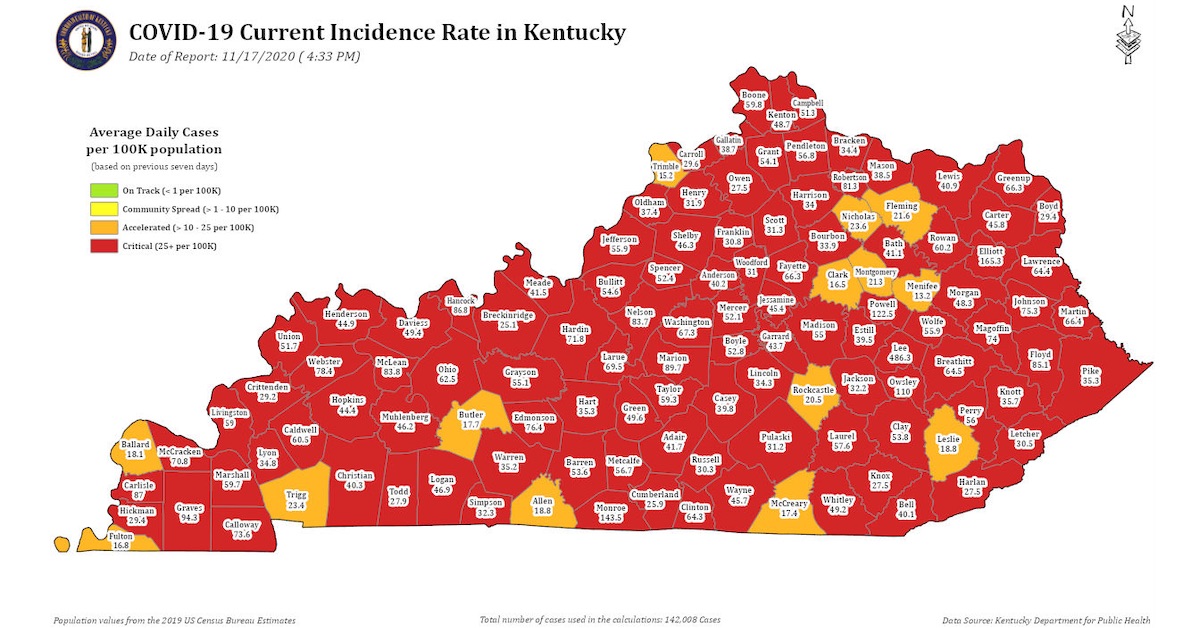The coronavirus is ripping through Kentucky, with the vast majority of counties classified by the state as “red zones” with critical COVID-19 spread.
Along with the state mask mandate, Gov. Andy Beshear for weeks has urged people in “red zone” counties to follow an additional series of recommendations to limit the spread of the coronavirus, including:
- Employers allowing employees to work from home
- Ordering take-out from restaurants
- Closing non-critical government offices from in-person services
- Cancelling or postponing public gatherings
- Not hosting or attending gatherings of any size
- Generally reducing one’s contacts throughout each day
WKMS News interviewed multiple county judge-executives and county public health officials in western Kentucky regarding how “red zone” recommendations are being encouraged and followed amid a continued escalation of cases. These elected officials and health leaders worry that lagging compliance of these recommendations, attributed in part to “pandemic fatigue,” is contributing to the startling increase in COVID-19 cases across the region.
Beshear said Tuesday during a COVID-19 press conference he would be announcing new mandatory restrictions for Wednesday, saying that “asking nicely hasn’t gotten the results that we need.”
Purchase Region
Late last week, McCracken County Judge Executive Craig Clymer in a press release laid out the increasingly grim situation the county faces in battling COVID-19. He recounted how he visited various businesses in the spring that had extra cold storage in case morgues ran out of space to store the dead.
“It was surreal to stand in the cold of a huge industrial refrigerator and calculate how many bodies could be stored. I don’t want to go there again,” Clymer said in the release. “I have heard people say: ‘I am not worried about it.’ That is an unquestionably dangerous, and potentially deadly practice.”
He went on to say with McCracken County setting a new daily case record of 92 cases last week, people need to follow the COVID-19 precautions to protect those who might be more vulnerable.
In an interview with WKMS News on Monday, Clymer said he and county emergency management officials plan to start weekly meetings to the public again to raise awareness about the virus threat. He said while it’s hard to say how closely people are following “red zone” recommendations, a big issue he sees is that a section of the population refuses to follow the state’s mask mandate in public places.
“[They] don’t even believe in it. Don’t believe it will help, believe it’s all a joke,” Clymer said. “If people would just follow the science, use their brains, and look out for each other, those few things I think we could have this thing licked before too long.”

Clymer said he also worries how effective another shutdown could be at battling the virus, with the prospect of some refusing to follow more restrictive orders.
Marshall County Health Department Public Information Officer Jennifer Brown said while some in her county are taking “red zone” recommendations seriously, others probably won’t wear a mask or follow virus precautions until they’re affected personally.
“They’re probably not terribly concerned about the new recommendations, nor were they concerned about the recommendations before,” Brown said. “We are definitely in a crisis situation. I think it’s something that we haven’t really dealt with before with COVID.”
Brown said cases will continue to rise if that disregard continues, with the looming potential for spread at upcoming holiday gatherings. She added she would expect stricter measures put in place by the governor if cases continue to escalate, measures similar to what was seen in the spring.
Graves County continues to see high infection levels after experiencing some of the earliest COVID-19 outbreaks in the state as the pandemic began. County Health Department Director Noel Coplen said both school districts in the county are currently utilizing online instruction, and the health department is working to spread community awareness of the county’s “red zone” status. The department is still receiving complaints of virus-related violations, Coplen said.
“We are receiving complaints and when we receive a complaint, we’re not physically going to every place but we’re trying to call. Our resources are limited,” Coplen said.
Coplen said he is observing many positive behaviors in the community, including long lines for drive-thru food service instead of in-person dining. He also said the county is doing a good job of following Beshear’s “red zone” recommendations, including the push to allow employees to work remotely.
“In the courthouse, in our government offices, a lot of people are working from home. Insurance offices, different lawyer’s officers, things like that. We see a lot of lobbies not being open and signs saying, ‘We’re here, call us.’ People have really learned how to operate differently,” Coplen said.
Coplen encourages Graves County businesses to follow the “red zone” recommendations, and for the community to model behaviors that will move Graves County to a lighter color on the state’s COVID-19 case incidence map.
Pennyrile Region
Pennyrile District Health Department Public Health Director Elicia Kite said the department backs the recommendations the governor made for the “red zone” counties, but “some [of the counties] are doing it and some are not.” She said it’s up to the local governments to take action because “they’re just recommendations.” Pennyrile District Health Department covers Caldwell, Crittenden, Livingston, Lyon and Trigg Counties.
Hopkins County is in the Pennyrile Region but has its own health department. Hopkins County Judge-Executive Jack Whitfield said the county health department is working on enforcing the governor’s “red zone” recommendations. The health department inspects whether or not local businesses are following “COVID-19 protocol” and posts the results on Facebook. Businesses either pass the inspection, or are issued a citation. Repeat offenders are indicated in the Facebook posts.
Whitfield said Hopkins County Schools has also decided to remain in nontraditional instruction until after winter break. According to a post on Facebook, the school system will be using virtual learning until at least Jan. 4, 2021.
Whitfield said he conducts weekly livestreamed updates on Facebook with Madisonville Mayor Kevin Cotton to encourage Hopkins County residents to social distance and wear their masks. He said he thinks compliance with the mask mandate has increased in the last couple of weeks, and he hopes that helps to bring numbers down.
Whitfield said county officials haven’t put any local mandates into effect.
“We’ve got the mandates from the state and the recommendations on the red zone requirements that we’re encouraging people to follow just to bring the spread down. We are in communication with our local medical providers. What we’re really concerned about is overwhelming our healthcare system,” he said.
As of Monday’s Kentucky COVID-19 incidence rate report, Hopkins County had 46.4 average daily cases per 100,000 people. A rate of 25 or more per 100,000 people puts counties in the ‘red zone.’
Lyon County Judge-Executive Wade White said he’s unaware of how any county would enforce a “red zone” recommendation as they’re written by the state.
“For example, how would a county judge having no police power enforce a recommendation from the governor for individuals to avoid non-essential activities outside of their home. How would I do that for 8500 people,” White said.
He said any enforcement of recommendations will need to come from the governor’s office.
White said a lot of people are wearing masks in Lyon County, but said he isn’t sure the mask mandate is the “end all that it has been put up as.” He said he is disappointed in the way the mask mandate has been handled.
White said when the pandemic began, some officials said there was no reason to wear a mask. He said people constantly touch their masks with their hands, potentially spreading coronavirus to the face covering.
“You’ve got to ask: why is it [coronavirus cases] sky-rocketing in the middle of the mask mandate?” White said.
White said he thinks the masks have caused people to “back off of” the six-foot social distancing rule.
“When they have a mask on, I think they feel like, ‘That’s all I’ve got to do and I can get closer to people,’ and I think that’s not the case, and that may be contributing to more [cases],” he said.
He said Lyon County has continued using glass partitions, encouraging social distancing and minimizing the number of people at the courthouse. He said businesses are continuing to keep people socially distanced “the best that they can.”
“I think that shows up in the numbers. Our numbers are lower than most anyone in western Kentucky,” White said.
As of Monday’s Kentucky COVID-19 incidence rate report, Lyon County had 34.8 average daily cases per 100,000 people. A rate of 25 or more per 100,000 people puts counties in the “red zone.”
In Trigg County, Judge-Executive Hollis Alexander said his office asked people to follow the “red zone” recommendations as best as they can. He said people should wear face-coverings, socially distance and place take-out orders at local restaurants. Alexander said people are complying “pretty well so far” with the guidance.
“With the type of recommendations, you’re going to have a select few that’s not [complying] and several that will,” he said.
Alexander said several businesses in the county have signage stating mask requirements but he doesn’t know of any that are turning away people who don’t comply.
“Maybe one or two,” he said. “I would hate to say that for sure because I don’t know that for sure.”
As of Monday’s Kentucky COVID-19 incidence rate report, Trigg County had 33.2 average daily cases per 100,000 people. A rate of 25 or more per 100,000 people puts counties in the “red zone.”
Christian County Health Department Public Information Officer Amanda Sweeney said she believes compliance with Beshear’s mask mandate is one of the most effective tools in fighting the pandemic, but the department is still witnessing violations throughout the community. She said officials are working to take enforcement action against businesses not requiring patrons to wear a mask.
“We see a lot of people who aren’t wearing their masks,” Sweeney said. “We try to make sure that businesses, when we receive complaints, we try to go in and talk to them, remind them to wear it. We had to give a couple of citations for that.”
Sweeney said she’s not aware of the number of businesses complying with Beshear’s recommendation to allow employees in “red zone” counties to work from home. However, she said many community members are taking the “red zone” designation seriously.
“Since we are a red zone county, I’ve seen a lot of organizations cancel specific plans just to make sure we’re not spreading that. But then we’ve seen other organizations who might continue. We’re kind of seeing both within the county,” she said.
She said the Christian County Health Department is working to provide awareness on federal, state and local health guidance to businesses and community members.
Henderson County Judge Executive Brad Schneider said the inability to enforce red zone guidelines is a key factor in the rise of COVID cases. He says local departments do not have the resources to proactively enforce coronavirus recommendations, and urged the community to follow the guidelines to keep their families safe.
Schneider said his office utilizes many media approaches to help guide people toward following red zone recommendations.
“We posted items and articles on both the county Facebook page and the city’s Facebook page, we’ve done Facebook live broadcasts to reiterate, urging our folks to follow the guidelines, we’ve had our district health director, who is Clay Horton, to join us and reiterate all those messages, as well as Linda White, CEO of our local hospital, to reaffirm all that.”
Schneider encourages people and businesses to adhere to red zone recommendations and combat “COVID fatigue” amid an increasing number of cases.
“When you wear a mask and keep social distance and maintain hand hygiene, you’re not only keeping yourself safe, you’re keeping your family safe. You’re keeping grandma safe. You keep your aunt and uncle safe. It’s not just about you. It’s about your family members and the people who are most vulnerable,” he said.
Daviess County Judge Executive Al Mattingly said his office urges people through media outreaches to follow coronavirus guidelines. But as businesses relax their enforcement on recommendations and pandemic fatigue sets in, Mattingly says cases have increased, and will only continue to do so.
“Early on, many of the businesses actually stationed people at the door; if you didn’t have a mask on then you weren’t allowed in, and I think that’s been relaxed somewhat, much to the detriment of our local population. I could probably say that everybody has covid fatigue right now, that’s the worst part of it, because that’s when people start to let their guard down.”
Mattingly said unlike mandates, recommendations cannot be enforced, leaving the community with limited resources to urge people to follow the guidelines. He says the population is “a hodgepodge of compliance”.
“Our population is made up of two types of people: the sky is falling and they’re scared to death, the other side is the ones who believe it’s a conspiracy theory and are doing only those things that are necessary to keep them from being banned.”
Mattingly said people can report noncompliance to the Daviess County Health Department.
Sydni Anderson, Dalton York, Liam Niemeyer and Scottlynn Ballard contributed to this report.





